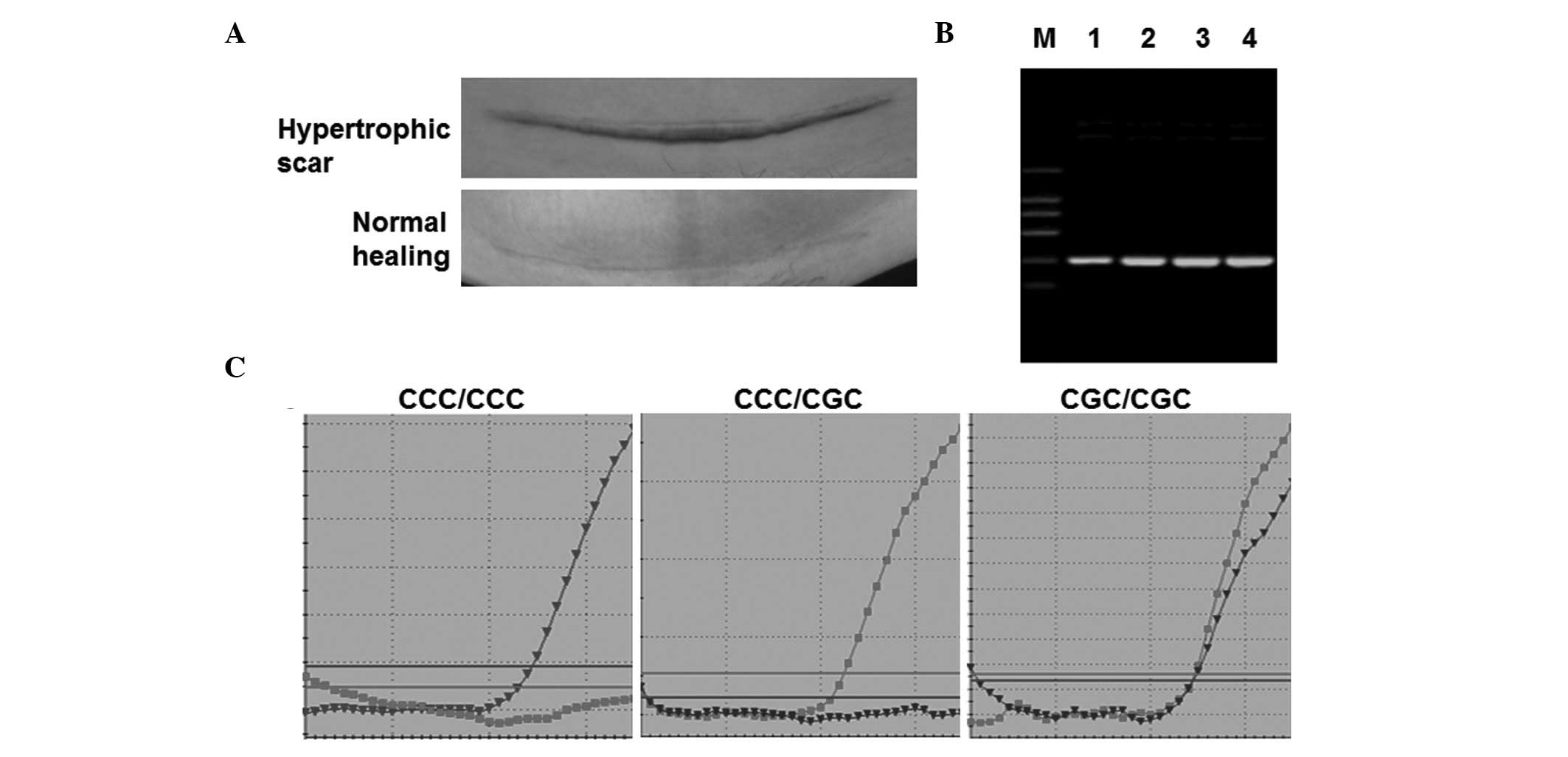|
1
|
Ceelen W, Pattyn P and Mareel M: Surgery,
wound healing, and metastasis: Recent insights and clinical
implications. Crit Rev Oncol Hematol. 89:16–26. 2014. View Article : Google Scholar : PubMed/NCBI
|
|
2
|
Greaves NS, Ashcroft KJ, Baguneid M and
Bayat A: Current understanding of molecular and cellular mechanisms
in fibroplasia and angiogenesis during acute wound healing. J
Dermatol Sci. 72:206–217. 2013. View Article : Google Scholar : PubMed/NCBI
|
|
3
|
Kazemi M, Salehi Z and Chakosari RJ: TP53
codon 72 polymorphism and breast cancer in northern Iran. Oncol
Res. 18:25–30. 2009. View Article : Google Scholar : PubMed/NCBI
|
|
4
|
Kara N, Karakus N, Ulusoy AN, Ozaslan C,
Gungor B and Bagci H: P53 codon 72 and HER2 codon 655
polymorphisms in Turkish breast cancer patients. DNA Cell Biol.
29:387–392. 2010. View Article : Google Scholar
|
|
5
|
Saed GM, Ladin D, Olson J, Han X, Hou Z
and Fivenson D: Analysis of p53 gene mutations in keloids using
polymerase chain reaction-based single-strand conformational
polymorphism and DNA sequencing. Arch Dermatol. 134:963–967.
1998.PubMed/NCBI
|
|
6
|
Liu YB, Gao JH, Duan HJ and Liu XJ:
Investigation of p53 gene mutations in keloids using PCR-SSCP.
Zhonghua Zheng Xing Wai Ke Za Zhi. 19:258–260. 2003.(In
Chinese).
|
|
7
|
Wang CM, Hiko H and Nakazawa N:
Investigation of p53 polymorphism for genetic predisposition of
keloid and hypertrophic scar. Zhonghua Zheng Xing Wai Ke Za Zhi.
21:32–35. 2005.(In Chinese).
|
|
8
|
Zhuo Y, Gao JH, Luo SQ, Zeng WS, Hu ZQ, Lu
F and Zhao YZ: p53 gene codon 72 polymorphism and susceptibility to
keloid. Zhonghua Zheng Xing Wai Ke Za Zhi. 21:201–203. 2005.(In
Chinese).
|
|
9
|
Yan L, Lü XY, Wang CM, Cao R, Yin YH, Jia
CS and Zhuang Q: Association between p53 gene codon 72 polymorphism
and keloid in Chinese population. Zhonghua Zheng Xing Wai Ke Za
Zhi. 23:428–430. 2007.(In Chinese).
|
|
10
|
WMA Declaration of Helsinki - Ethical
Principles for Medical Research Involving Human Subjects. 59th WMA
General Assembly; Seoul, Republic of Korea. October 2008; Available
at http://www.wma.net/en/30publications/10policies/b3/uri.
Accessed February 7, 2014
|
|
11
|
Penn JW, Grobbelaar AO and Rolfe KJ: The
role of the TGF-β family in wound healing, burns and scarring: a
review. Int J Burns Trauma. 2:18–28. 2012.
|
|
12
|
van den Broek LJ, Kroeze KL, Waaijman T,
et al: Differential response of human adipose tissue-derived
mesenchymal stem cells, dermal fibroblasts and keratinocytes to
burn wound exudates: Potential role of skin-specific chemokine
CCL27. Tissue Eng Part A. 20:197–209. 2014.
|
|
13
|
Albrecht-Schgoer K, Schgoer W, Theurl M,
et al: Topical secretoneurin gene therapy accelerates diabetic
wound healing by interaction between heparan-sulfate proteoglycans
and basic FGF. Angiogenesis. 17:27–36. 2014. View Article : Google Scholar
|
|
14
|
Kong P, Xie X, Li F, Liu Y and Lu Y:
Placenta mesenchymal stem cell accelerates wound healing by
enhancing angiogenesis in diabetic Goto-Kakizaki (GK) rats. Biochem
Biophys Res Commun. 438:410–419. 2013. View Article : Google Scholar : PubMed/NCBI
|
|
15
|
Aarabi S, Bhatt KA, Shi Y, et al:
Mechanical load initiates hypertrophic scar formation through
decreased cellular apoptosis. FASEB J. 21:3250–3261. 2007.
View Article : Google Scholar : PubMed/NCBI
|
|
16
|
De Felice B, Garbi C, Santoriello M,
Santillo A and Wilson RR: Differential apoptosis markers in human
keloids and hypertrophic scars fibroblasts. Mol Cell Biochem.
327:191–201. 2009.PubMed/NCBI
|
|
17
|
Zhuo Y, Gao JH, Luo SQ, et al: Evaluation
of high-risk individuals for keloid and polymorphism of p53 gene
codon 72. Chin J Clin Rehabil. 9(22): 130–131. 2005.(In
chinese).
|
|
18
|
Kay C, Jeyendran RS and Coulam CB: p53
tumour suppressor gene polymorphism is associated with recurrent
implantation failure. Reprod Biomed Online. 13:492–496. 2006.
View Article : Google Scholar : PubMed/NCBI
|











